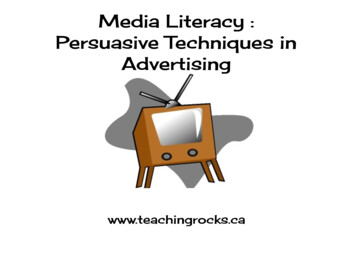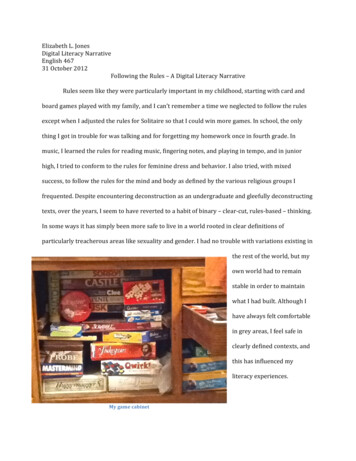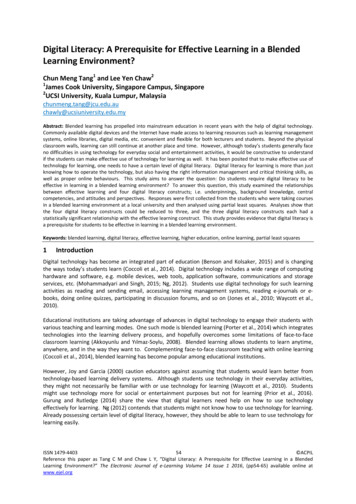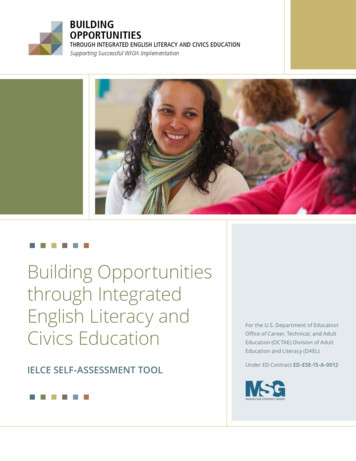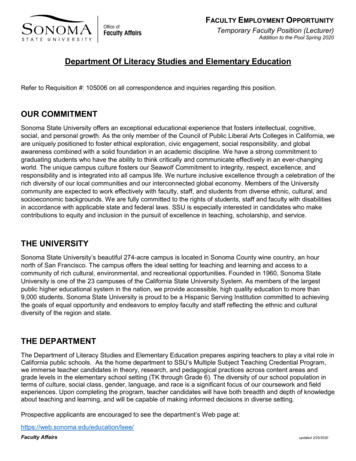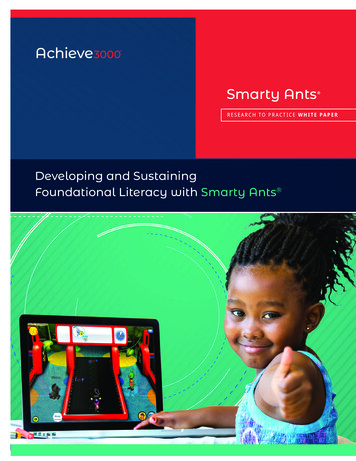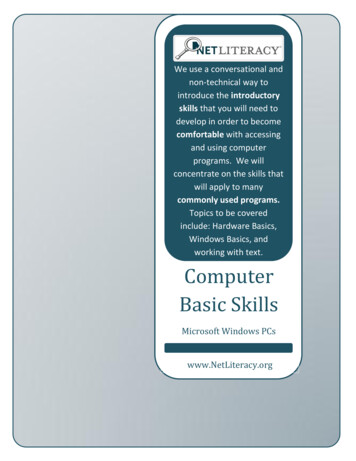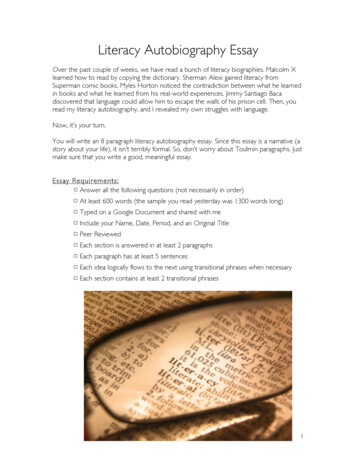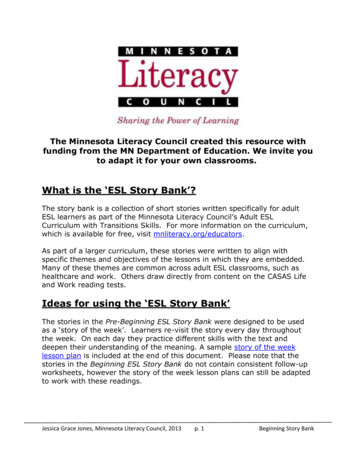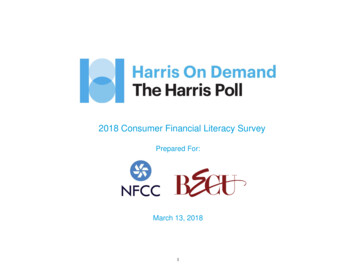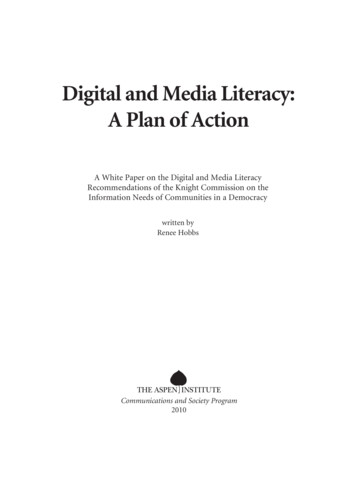
Transcription
Digital and Media Literacy:A Plan of ActionA White Paper on the Digital and Media LiteracyRecommendations of the Knight Commission on theInformation Needs of Communities in a Democracywritten byRenee HobbsCommunications and Society Program2010
The Aspen Institute and the John S. and James L. Knight Foundation invite you to join thepublic dialogue around the Knight Commission’s recommendations atwww.knightcomm.org or by using Twitter hashtag #knightcomm.Copyright 2010 by The Aspen InstituteThe Aspen InstituteOne Dupont Circle, NWSuite 700Washington, D.C. 20036Published in the United States of America in 2010 by The Aspen InstituteAll rights reservedPrinted in the United States of AmericaISBN: 0-89843-535-810/020Individuals are encouraged to cite this paper and its contents.In doing so, please include the following attribution:The Aspen Institute Communications and Society Program, Digital and Media Literacy:A Plan of Action, Washington, D.C.: The Aspen Institute, November 2010.For more information, contact:The Aspen InstituteCommunications and Society ProgramOne Dupont Circle, NWSuite 700Washington, D.C. 20036Phone: (202) 736-5818Fax: (202) 467-0790www.aspeninstitute.org/c&sTo purchase additional copies of this paper, please contact:The Aspen InstitutePublications OfficeP.O. Box 222109 Houghton Lab LaneQueenstown, MD 21658Phone: (410) 820-5326Fax: (410) 827-9174Cover background graphic was created in part at www.wordle.net.Communications and Society ProgramA project of the Aspen Institute Communications and Society Programand the John S. and James L. Knight Foundation.
ContentsFrom Report to Action. vExecutive Summary. viiDigital and Media Literacy:A Plan of Action, Renee HobbsThe Knight Commission Recommendation. 15The Heritage of Digital and Media Literacy. 16Meeting the Needs of All. 20Where Learning Occurs. 21Learning and Teaching: What Works. 22Issues to Consider When Implementing Digitaland Media Literacy Programs. 25A Plan of Action: 10 Recommendations. 36Who Should Do What. 46Conclusion: Imagining the Future. 50AppendixPortraits of Success. 59About the Author. 65About the Communications and Society Program. 67
From Report to ActionImplementing the Recommendations of theKnight Commission on the Information Needs ofCommunities in a DemocracyIn October 2009, the Knight Commission on the Information Needs ofCommunities in a Democracy released its report, Informing Communities:Sustaining Democracy in the Digital Age, with 15 recommendations to better meetcommunity information needs.Immediately following the release of Informing Communities, the AspenInstitute Communications and Society Program and the John S. and James L.Knight Foundation partnered to explore ways to implement the Commission’srecommendations.As a result, the Aspen Institute commissioned a series of white papers with thepurpose of moving the Knight Commission recommendations from report intoaction. The topics of the commissioned papers include: Universal BroadbandCivic EngagementGovernment TransparencyOnline HubsDigital and Media LiteracyLocal JournalismPublic MediaAssessing the Information Health of CommunitiesThe following paper is one of those white papers.This paper is written from the perspective of the author individually. The ideasand proposals herein are those of the author, and do not necessarily representthe views of the Aspen Institute, the John S. and James L. Knight Foundation, themembers of the Knight Commission on the Information Needs of Communitiesin a Democracy, or any other institution. Unless attributed to a particular person, none of the comments or ideas contained in this report should be taken asembodying the views or carrying the endorsement of any person other than theauthor.v
Digital and Media Literacy:A Plan of ActionExecutive SummaryThe time to bring digital and media literacy into the mainstream of Americancommunities is now. People need the ability to access, analyze and engage in critical thinking about the array of messages they receive and send in order to makeinformed decisions about the everyday issues they face regarding health, work,politics and leisure. Most American families live in “constantly connected” homeswith 500 TV channels, broadband Internet access, and mobile phones offeringon-screen, interactive activities at the touch of a fingertip. In an age of informationoverload, people need to allocate the scarce resource of human attention to quality, high-value messages that have relevance to their lives.Today full participation in contemporary culture requires not just consuming messages, but also creating and sharing them. To fulfill the promise of digital citizenship, Americans must acquire multimedia communication skills thatinclude the ability to compose messages using language, graphic design, images,and sound, and know how to use these skills to engage in the civic life of theircommunities. These competencies must be developed in formal educational settings, especially in K–12 and higher education, as well as informal settings. Theinclusion of digital and media literacy in formal education can be a bridge acrossdigital divides and cultural enclaves, a way to energize learners and make connections across subject areas, and a means for providing more equal opportunities indigital environments.This report offers a plan of action for how to bring digital and media literacyeducation into formal and informal settings through a community educationmovement. This work will depend on the active support of many stakeholders:educational leaders at the local, state and federal levels; trustees of public libraries;leaders of community-based organizations; state and federal officials; membersof the business community; leaders in media and technology industries, and thefoundation community. It will take the energy and imagination of people whorecognize that the time is now to support the development of digital and medialiteracy education for all our nation’s citizens, young and old.In this report, we define digital and media literacy as a constellation of life skillsthat are necessary for full participation in our media-saturated, information-richsociety. These include the ability to do the following: Make responsible choices and access information by locating and sharingmaterials and comprehending information and ideasvii
viiiDigital and Media Literacy: A Plan of Action Analyze messages in a variety of forms by identifying the author, purposeand point of view, and evaluating the quality and credibility of the content Create content in a variety of forms, making use of language, images,sound, and new digital tools and technologies Reflect on one’s own conduct and communication behavior by applyingsocial responsibility and ethical principles Take social action by working individually and collaboratively to shareknowledge and solve problems in the family, workplace and community,and by participating as a member of a communityThese digital and media literacy competencies, which constitute core competencies of citizenship in the digital age, have enormous practical value. To be ableto apply for jobs online, people need skills to find relevant information. To getrelevant health information, people need to be able to distinguish between a marketing ploy for nutritional supplements and solid information based on researchevidence. To take advantage of online educational opportunities, people need tohave a good understanding of how knowledge is constructed and how it representsreality and articulates a point of view. For people to take social action and trulyengage in actual civic activities that improve their communities, they need to feel asense of empowerment that comes from working collaboratively to solve problems.There is growing momentum to support the integration of digital and medialiteracy into education. The U.S. Department of Education’s 2010 technology plan,“Transforming American Education: Learning Powered by Technology,” notes,“Whether the domain is English language arts, mathematics, sciences, social studies, history, art, or music, 21st-century competencies and expertise such as criticalthinking, complex problem solving, collaboration, and multimedia communication should be woven into all content areas. These competencies are necessaryto become expert learners, which we all must be if we are to adapt to our rapidlychanging world over the course of our lives, and that involves developing deepunderstanding within specific content areas and making the connections betweenthem” (p. vi).Senator Jay Rockefeller (D-WV) has proposed a bill, the 21st Century SkillsIncentive Fund Act, that would provide matching federal funds to states offeringstudents curriculum options that include information literacy and media literacy.According to the bill, “Students need to go beyond just learning today’s academiccontext to develop critical thinking and problem solving skills, communicationsskills, creativity and innovation skills, collaboration skills, contextual learningskills, and information and media literacy skills” (S. 1029, 2009). If passed, the billwould appropriate 100 million a year for states that develop a comprehensiveplan to implement a statewide 21st-century skills initiative and are able to supply
Executive Summarymatching funds. Similarly, members of Congress Tammy Baldwin (D-WI), andShelley Moore Capito (R-WV) have sponsored the Healthy Media for Youth Act(H.R.4925) which authorizes 40 million to support media literacy programs forchildren and youth. But these efforts, as substantial as they are, even if they arepassed, will not be enough.At the heart of this momentum is the recognition that we must work to promotepeople’s capacity to simultaneously empower and protect themselves and theirfamilies as everyday lives become more saturated and enmeshed with information.As philosopher John Dewey made clear, true education arises from thoughtfulexploration of the genuine problems we encounter in daily life. Information needsare both personal and civic (Knight Commission, 2009). We look to digital andmedia literacy to help us more deeply engage with ideas and information to makedecisions and participate in cultural life.Rather than viewing empowerment and protection as an either-or proposition,they must be seen as two sides of the same coin. Because mass media, popularculture and digital technologies contribute to shaping people’s attitudes, behaviorsand values, not only in childhood but across a lifetime, there is a public interestin addressing potential harms. For healthy development, children and youth needprivacy, physical and psychological safety, and freedom from exposure to objectionable, disturbing or inappropriate material. At the same time, media and technology can empower individuals and groups. People gain many personal, socialand cultural benefits from making wise choices about information and entertainment, using digital tools for self-expression and communication, and participating in online communities with people around the neighborhood and around theworld who share their interests and concerns.To strengthen digital citizenship and make digital and media literacy part ofmainstream education in the United States, a series of key steps, both large andsmall, will be necessary. In this report, a plan of action includes 10 recommendations for local, regional, state and national initiatives aligned with the themes ofcommunity action, teacher education, research and assessment, parent outreach,national visibility and stakeholder engagement. These action steps do more thanbring digital and media literacy into the public eye. Each step provides specificconcrete programs and services to meet the diverse needs of our nation’s citizens,young and old, and build the capacity for digital and media literacy to thrive as acommunity education movement.Support Community-Level Digital and Media Literacy Initiatives1. Map existing community resources and offer small grants to promotecommunity partnerships to integrate digital and media literacy competencies into existing programs.ix
xDigital and Media Literacy: A Plan of Action2. Support a national network of summer learning programs to integratedigital and media literacy into public charter schools.3. Support a Digital and Media Literacy (DML) Youth Corps to bring digitaland media literacy to underserved communities and special populationsvia public libraries, museums and other community centers.Develop Partnerships for Teacher Education4. Support interdisciplinary bridge building in higher education to integratecore principles of digital and media literacy education into teacher preparation programs.5. Create district-level initiatives that support digital and media literacyacross K–12 via community and media partnerships.6. Partner with media and technology companies to bring local and nationalnews media more fully into education programs in ways that promotecivic engagement.Research and Assessment7. Develop online measures of media and digital literacy to assess learningp
Digital and Media Literacy: A Plan of Action Executive Summary The time to bring digital and media literacy into the mainstream of American communities is now. People need the ability to access, analyze and engage in criti-cal thinking about the array of messages they receive and send in order to make informed decisions about the everyday issues they face regarding health, work, politics and .
